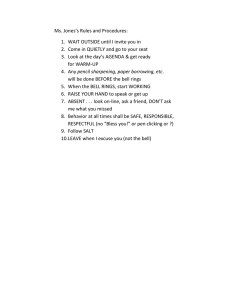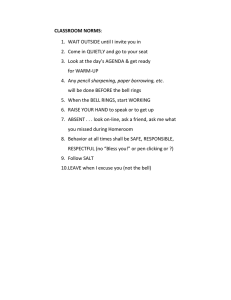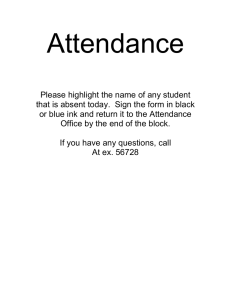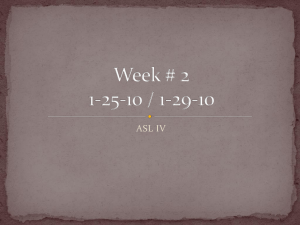The First Five Minutes
advertisement
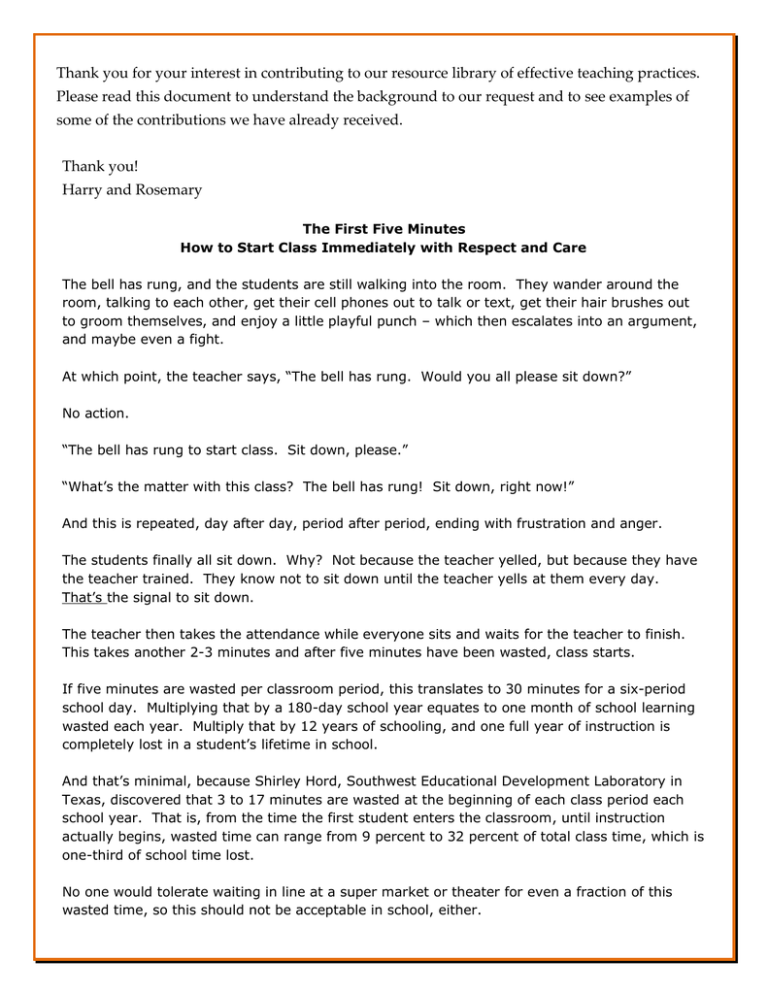
Thank you for your interest in contributing to our resource library of effective teaching practices. Please read this document to understand the background to our request and to see examples of some of the contributions we have already received. Thank you! Harry and Rosemary The First Five Minutes How to Start Class Immediately with Respect and Care The bell has rung, and the students are still walking into the room. They wander around the room, talking to each other, get their cell phones out to talk or text, get their hair brushes out to groom themselves, and enjoy a little playful punch – which then escalates into an argument, and maybe even a fight. At which point, the teacher says, “The bell has rung. Would you all please sit down?” No action. “The bell has rung to start class. Sit down, please.” “What’s the matter with this class? The bell has rung! Sit down, right now!” And this is repeated, day after day, period after period, ending with frustration and anger. The students finally all sit down. Why? Not because the teacher yelled, but because they have the teacher trained. They know not to sit down until the teacher yells at them every day. That’s the signal to sit down. The teacher then takes the attendance while everyone sits and waits for the teacher to finish. This takes another 2-3 minutes and after five minutes have been wasted, class starts. If five minutes are wasted per classroom period, this translates to 30 minutes for a six-period school day. Multiplying that by a 180-day school year equates to one month of school learning wasted each year. Multiply that by 12 years of schooling, and one full year of instruction is completely lost in a student’s lifetime in school. And that’s minimal, because Shirley Hord, Southwest Educational Development Laboratory in Texas, discovered that 3 to 17 minutes are wasted at the beginning of each class period each school year. That is, from the time the first student enters the classroom, until instruction actually begins, wasted time can range from 9 percent to 32 percent of total class time, which is one-third of school time lost. No one would tolerate waiting in line at a super market or theater for even a fraction of this wasted time, so this should not be acceptable in school, either. It’s All in How You Start Effective teachers know how to start class immediately. 1. 2. 3. 4. 5. You greet the students at the door. They go through their start of class routine. They sit in their assigned seats. They look at the agenda. They begin the opening assignment. During this time while the students are preparing themselves for the class and beginning their opening assignments, the teacher is taking the attendance or doing whatever house-keeping tasks are needed, and in five minutes, instruction begins. These are just some of the examples we have collected from teachers and how they maximize the first five minutes of class. Secondary Examples Orchestra When my students walk in the room, they retrieve their music and instruments, and are in their seats with all required supplies when the bell rings. I have three Class Managers who help me with classroom procedures. One leads body warmups when the bell rings. While body warm-ups are going on, another Class Manager checks attendance (I also enter attendance into the grade book at this time). After warm-ups, the students have their instruments ready for tuning. The third Class Manager leads tuning. I walk around to check if students have supplies on hand while this is happening. I also help students who are having tuning or instrument problems at this time. Our warm-ups and tuning are done in 8 minutes and we are ready to start our music. Nile Wilson San Antonio, Texas Science I have a procedure for entering the classroom: 1) pick up handouts, 2) be seated, and 3) begin the bellwork. When students walk in the door, they proceed to the shelf where the papers they will need for the class period are stored. Papers are picked up and students find their seats. The daily agenda, objective, and bellwork assignment are always posted. Students know they are to begin working on the bellwork assignment. When they finish, they work on something else or wait quietly. 2 During this time, I take attendance and return papers (or a student helper returns the papers). When I can see that most students have completed the bellwork, I begin speaking. “Thank you for coming in and getting to work. If you are still working, please continue as I tell you the agenda, ‘the game plan,’ for today.” I point to the posted agenda and verbally repeat it. If papers have been returned to them, I use this time to give feedback on the assignment, and then we start the day. Karen Rogers (Karen specializes in challenging students—at-risk, SPED, and ELL). Olathe, Kansas Language Arts The students walk in, take their assigned seats, read the agenda and bellwork on the projected Protopage, and immediately go to work. A student who has been absent checks the make-up work folder. During this time, I do the necessary housekeeping tasks, such as submitting attendance, and checking and collecting the homework. After the bellwork, we start class. The process takes three to five minutes—five minutes when I have homework to check. Oretha Ferguson Fort Smith, Arkansas Communications Arts In five minutes, students walk into the room; retrieve their interactive notebooks; review the agenda, learning target, and essential question for the day (written on the whiteboard); and then, journal write to the prompt on the Smartboard. Journal prompts often ask them to think about an idea connected to what we are learning about that day. After the five minutes (a timer is used), I often call on a few students to share their answers to begin instruction. Brandy Hackett Moberly, Missouri Physical Education The students come to PE, change into their PE attire, and “Start Walking.” No one tells them what to do; they know the procedure. This procedure is repeated every day. Steve Geiman and colleagues Waynesboro, Virginia 3 Elementary Examples First Grade My first grade students enter the classroom and begin a series of morning opening procedures: backpacks, home learning folder, lunch and snack money, notes, and morning assignment. During this time, I take the attendance; they listen to the principal’s message; and they recite the Pledge of Allegiance. I can’t stress enough how important procedures and routines are. Many people do not believe that young children can follow procedures and routines. My classroom is proof that it works. Maureen Conley Central Islip, New York Third Grade When the bell rings, I greet my students on the blacktop. I walk past each one saying comments like, “I am glad to see you” and “We’re going to have a great day.” We walk to our classroom, where I welcome them inside. We greet each other at the door with a handshake and eye contact, saying “Good morning.” It’s a great way to start the day, showing respect for one another and making everyone feel welcomed to our classroom. Once students enter, they do their morning duties of unpacking, taking attendance, and turning in homework. Then they start the bell-work assignment on the board. Our morning runs efficiently, and the day is off to a great start! Sarah Jondahl Brentwood, California First Grade When the bell rings, I stand at the door greeting my students. I say, "Good morning,” to each of my students, including their name in the greeting. As students walk in, there is Disney music playing and the procedures posted on the board stating: unpack & turn in work, sharpen pencils, get breakfast, start morning work. During this, I am documenting attendance and lunch count. I also watch student behavior. If I see someone looking sad, I make sure I approach them and say good morning again, and ask them if everything is okay. We then listen to announcements. I have used this since Day One of my teaching experience, and it has worked great. Janelle Papazian Phoenix, Arizona 4 Fifth Grade English Language Arts I teach three separate sections of 5th grade English Language Arts at a Catholic elementary school. Each section or homeroom consists of 30 students, and I have the students in my classroom for 90 minutes every day. Having a set routine at the beginning of each class period allows me uninterrupted time to complete my daily housekeeping tasks, as well as walk around my classroom and check the students’ homework. When students enter my classroom, their daily Bell Ringer is projected on my Promethean Board. The students are to take out their agendas and copy down their homework. Students then place their homework assignments from the previous night on their desks. If the homework is not completed, they are to complete a missing assignment slip. Next, students work on their daily oral language or reading comprehension assignment. Following this, students silently read their independent reading books until the lesson begins (in a few minutes). Megan Toujouse Covington, Louisiana Grade 6 Science I greet my students at the door as they are walking into the room. I have found that this is the best time for me to address their non-classroom-related concerns, rather than it being done during instructional time. Upon entering the classroom, the students read our Do-Now Board, which always has our daily task and any materials they may need to pick up at the front work bench. They also complete their task and/or lab notebook and take out all supplies needed for class - lab notebook, writing utensil, homework, etc. During this time, I am taking attendance. Everything in the classroom has a procedure and the students know how to carry out our daily tasks within the first five minutes. Having an orderly system and procedures in place has really helped my students to focus on learning for the day! Cristina Bianchi Providence, Rhode Island Pre-school Special Education I teach pre-school Special Ed with 8 special needs students and 4 typical developing students— 12 students, 3-5 years old. The special needs students are greeted by classroom assistants off the bus and or car/van into the school, and escorted into the hallway by the bathroom. Children take off their coats and book bags and place them on a chair. The teacher helps the children with their bath rooming needs. Once the children are finished, they pick up their coat and book bag, and hold it in front of them and walk down the hallway with the teacher in front of the line. 5 Once the children enter the classroom, they place their coat and book bag into their cubby. There are 3 centers the children are initially able to go to: 1. Art Table 2. Sandbox 3. Carpet Area All other centers are closed. Four students are assigned to go to a center for 5-7 minutes. During this time, I check each book bag, write a quick note to a parent, and take attendance. A timer (or when the red is all gone) is used to signal transition to the next center. My students have all learned transition procedures. Once the timer sounds or the “Red is all gone,” the children can move to other centers: book center, role play, art center, etc. The children like going to a center and staying there for 5-7 minutes. The children ‘stay in the centers’ and do not ‘flit’ around the room, because the climate of the classroom is organized and structured. The children are engaged the minute they arrive in the classroom in an orderly fashion, until they are dismissed. Robin Barlak Parma, Ohio Fourth Grade As my students enter with breakfast in hand, they are greeted and receive pencils. Students unpack homework, copy assignments into their agenda, and complete Morning Work as they eat. Next, students discard breakfast trash and visit the bathroom. Then, students read the Morning Message and answer the daily problem. Back at their desk, students review and turn in the morning work, clear their desk, and read a book of choice. By this time, students are listening to announcements. Students know to go directly to the rug and sit in a circle for our Morning Meeting as soon as the announcements are over. These routines and procedures provide students with a safe and expected environment. Every second of every minute is purposeful. Patricia Candies St. Rose, Louisiana Fifth Grade I have begun each morning the same way since my very first day of teaching five years ago. I plan each morning the previous afternoon with a new schedule, a daily “I Can”, and make sure my bellringer is changed and ready so students can immediately come in and get on task. 6 My first key ingredient to a good morning is music (classical, “The Piano Guys”); I then stand at the door to greet students. As students work, I check attendance and prepare for my first lesson of the day! This is also a great time to walk around and make sure students seem visibly OK, and if not, I give a hug and kind words. Remember, the day is early, and as their teacher, you can make it brighter. Amanda Brooks Dyersburg, Tennessee Second Grade I learned at Ball State University to have a plan put into place for the first five minutes of class, the most crucial part of beginning a successful day of learning. When the bell rings at 8:20 each morning and the children are released to enter my classroom, I immediately meet them at the door to greet each child. This makes them feel welcome and invited to their learning environment. As they enter the classroom, they are met with a morning message on my easel giving them short and “to the point” steps on what to do when they enter. The first step is to hang their coats and backpacks up in their lockers, and ensuring they have their “take home” folder in hand. Next is to find their seat, put their folder in their desk, get two pencils out, and sharpen them (if needed). Then, they know to quietly sit and begin working on their morning work/bell work activity. I always have this out ready on their desks each morning. Once they finish, they choose a book from the book bag on their chair, and read silently until I give them further directions. Planning and posting the steps that children need to take each morning, greeting children at the door, and having a bell work for them to work on when they arrive can make for a great morning, and wonderful day of learning. Kasey Oetting Muncie, Indiana Third Grade As my third graders walk into our classroom, they say “Good Morning” to everyone, then put down their book bags. They proceed to read their morning message, the outcomes for the day, and their bell work. They take their own attendance in Active Inspire, complete their bell work, and eat their breakfast. While they are doing this, I can take care of other teacher duties, such as collecting notes/money or passing out office notes. I cannot visualize my classroom functioning without procedures and routines. Students need consistency and structure. Tiffany Landrum St. Rose, Louisiana 7 Please share with us your “First Five Minutes.” Tell us what you do with specific steps, the grade level you teach, the subjects you teach, where you teach, and anything else you wish to share. Send your story, along with a photo or two, if you wish to Harry and Rosemary Wong HWong@HarryWong.com and RWong@HarryWong.com Thank you for growing the teaching profession with effective practices! 8

